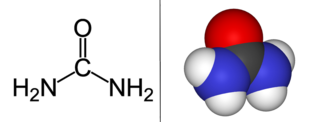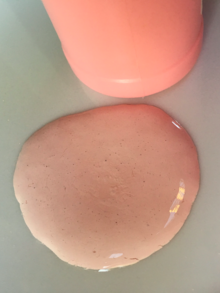
Pilocarpine is a medication used to reduce pressure inside the eye and treat dry mouth. As an eye drop it is used to manage angle closure glaucoma until surgery can be performed, ocular hypertension, primary open angle glaucoma, and to constrict the pupil after dilation. However, due to its side effects it is no longer typically used for long-term management. Onset of effects with the drops is typically within an hour and lasts for up to a day. By mouth it is used for dry mouth as a result of Sjögren syndrome or radiation therapy.

Miconazole, sold under the brand name Monistat among others, is an antifungal medication used to treat ring worm, pityriasis versicolor, and yeast infections of the skin or vagina. It is used for ring worm of the body, groin, and feet. It is applied to the skin or vagina as a cream or ointment.
Antipruritics, abirritants, or anti-itch drugs, are medications that inhibit the itching often associated with sunburns, allergic reactions, eczema, psoriasis, chickenpox, fungal infections, insect bites and stings like those from mosquitoes, fleas, and mites, and contact dermatitis and urticaria caused by plants such as poison ivy or stinging nettle. It can also be caused by chronic kidney disease and related conditions.

Terbinafine, sold under the brand name Lamisil among others, is an antifungal medication used to treat pityriasis versicolor, fungal nail infections, and ringworm including jock itch and athlete's foot. It is either taken by mouth or applied to the skin as a cream or ointment. The cream and ointment are not effective for nail infections.

Cefalexin, also spelled cephalexin, is an antibiotic that can treat a number of bacterial infections. It kills gram-positive and some gram-negative bacteria by disrupting the growth of the bacterial cell wall. Cefalexin is a beta-lactam antibiotic within the class of first-generation cephalosporins. It works similarly to other agents within this class, including intravenous cefazolin, but can be taken by mouth.

Budesonide/formoterol, sold under the brand name Symbicort among others, is a fixed-dose combination medication used in the management of asthma or chronic obstructive pulmonary disease (COPD). It contains budesonide, a steroid and formoterol, a long-acting β2-agonist (LABA). The product monograph does not support its use for sudden worsening or treatment of active bronchospasm. However, a 2020 review of the literature does support such use. It is used by breathing in the medication.

Betamethasone is a steroid medication. It is used for a number of diseases including rheumatic disorders such as rheumatoid arthritis and systemic lupus erythematosus, skin diseases such as dermatitis and psoriasis, allergic conditions such as asthma and angioedema, preterm labor to speed the development of the baby's lungs, Crohn's disease, cancers such as leukemia, and along with fludrocortisone for adrenocortical insufficiency, among others. It can be taken by mouth, injected into a muscle, or applied to the skin, typically in cream, lotion, or liquid forms.

Ethambutol is a medication primarily used to treat tuberculosis. It is usually given in combination with other tuberculosis medications, such as isoniazid, rifampicin and pyrazinamide. It may also be used to treat Mycobacterium avium complex, and Mycobacterium kansasii. It is taken by mouth.

Benzyl benzoate is an organic compound which is used as a medication and insect repellent. As a medication it is used to treat scabies and lice. For scabies either permethrin or malathion is typically preferred. It is applied to the skin as a lotion. Typically two to three applications are needed. It is also present in Balsam of Peru, Tolu balsam, and in a number of flowers.
Rifampicin/isoniazid/pyrazinamide, also known as rifampin/isoniazid/pyrazinamide, and sold under the trade name Rifater, is a medication used to treat tuberculosis. It is a fixed dose combination of rifampicin, isoniazid, and pyrazinamide. It is used either by itself or along with other antituberculosis medication. It is taken by mouth.
Pramocaine is a topical anesthetic discovered at Abbott Laboratories in 1953 and used as an antipruritic. During research and development, pramocaine hydrochloride stood out among a series of alkoxy aryl alkamine ethers as an especially good topical local anesthetic agent. Pharmacologic study revealed it to be potent and of low acute and subacute toxicity, well tolerated by most mucous membranes and of a low sensitizing index in humans. Like other local anesthetics, pramocaine decreases the permeability of neuronal membranes to sodium ions, blocking both initiation and conduction of nerve impulses. Depolarization and repolarization of excitable neural membranes is thus inhibited, leading to numbness.

Clotrimazole, sold under the brand name Lotrimin, among others, is an antifungal medication. It is used to treat vaginal yeast infections, oral thrush, diaper rash, tinea versicolor, and types of ringworm including athlete's foot and jock itch. It can be taken by mouth or applied as a cream to the skin or in the vagina.

Benzathine benzylpenicillin, also known as benzathine penicillin G, is an antibiotic medication useful for the treatment of a number of bacterial infections. Specifically it is used to treat strep throat, diphtheria, syphilis, and yaws. It is also used to prevent rheumatic fever. It is given by injection into a muscle.
Procaine benzylpenicillin also known as penicillin G procaine, is an antibiotic useful for the treatment of a number of bacterial infections. Specifically it is used for syphilis, anthrax, mouth infections, pneumonia, diphtheria, cellulitis, and animal bites. It is given by injection into a muscle.

Urea, also known as carbamide-containing cream, is used as a medication and applied to the skin to treat dryness and itching such as may occur in psoriasis, dermatitis, or ichthyosis. It may also be used to soften nails.
Lamivudine/nevirapine/zidovudine (3TC/NVP/AZT) is a fixed-dose combination antiretroviral medication used to treat HIV/AIDS. It contains lamivudine, nevirapine, and zidovudine. It is either used by itself or along with other antiretrovirals. It is a recommended treatment in those who are pregnant. It is taken by mouth twice a day.
Podophyllum resin, also known as podophyllum or podophyllin, is a resin made from the roots of the American mandrake. It is used as a medication to treat genital warts and plantar warts, including in people with HIV/AIDS. It is not recommended in HPV infections without external warts. Application by a healthcare provider to the skin is recommended.

Potassium permanganate is used as a medication for a number of skin conditions. This includes fungal infections of the foot, impetigo, pemphigus, superficial wounds, dermatitis, and tropical ulcers. For tropical ulcers it is used together with procaine benzylpenicillin. Typically it is used in skin conditions that produce a lot of liquid. It can be applied as a soaked dressing or a bath.

Salicylic acid is used as a medicine to help remove the outer layer of the skin. As such it is used to treat warts, skin tags, calluses, psoriasis, dandruff, acne, ringworm, and ichthyosis. For conditions other than warts, it is often used together with other medications. It is applied to the area affected.

Fluorescein is used to help in the diagnosis of a number of eye problems. When applied as a drop or within a strip of paper to the surface of the eye it is used to help detect eye injuries such as foreign bodies and corneal abrasions. When given by mouth or injection into a vein it is used to help evaluate the blood vessels in the back of the eye during fluorescein angiography.













